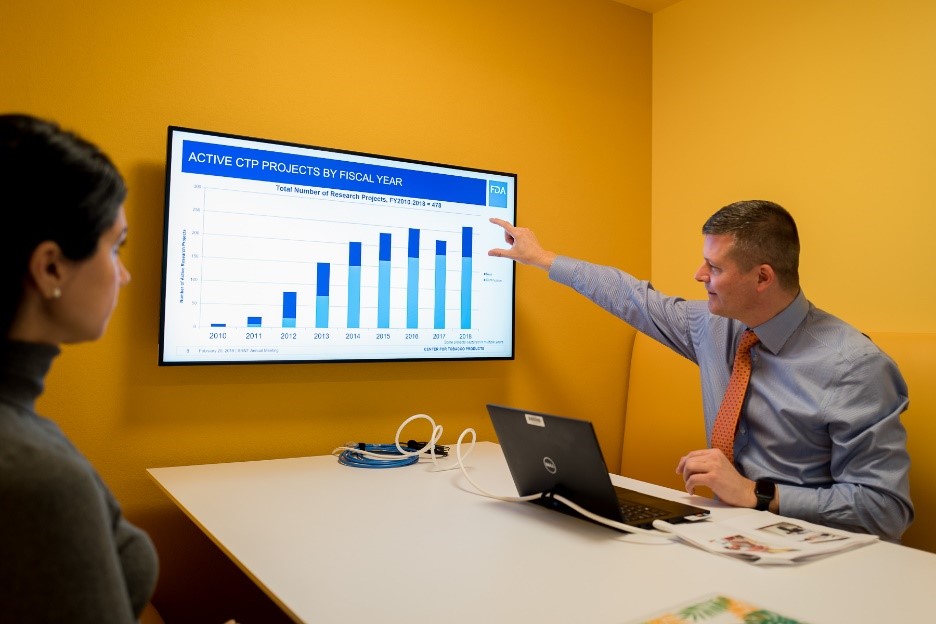Webpage
Question and Answer with Matt Holman, Ph.D., Director of CTP’s Office of Science
Preview Text for Your Web Page
The following text is a preview of content you can place on your website.

Matt Holman, Ph.D., Director of the FDA’s Center for Tobacco Products’ (CTP) Office of Science, has over 17 years of experience working as a regulatory scientist, getting his start at FDA in the Center for Drug Evaluation and Research (CDER). Holman—a biochemist—helped to oversee the regulation of a wide range of over-the-counter products while at CDER, and in his last position as Deputy Director of the Division of Nonprescription Regulation Development, his policy decisions affected half of the over-the-counter drugs the division regulated at the time. Holman came to CTP to contribute to the improvement of public health and reduction of the death and disease associated with tobacco use. During Holman’s first six years at CTP, he headed the Division of Product Science, focusing on chemical, engineering, and microbiology aspects of tobacco products and use. His time spent in this role led him to become interested in doing even more to contribute to protecting public health through tobacco regulation. In 2017, Holman became the director of CTP’s Office of Science. In this Q&A, Holman speaks to the future of tobacco regulatory science as it evolves with the technology and introduction of new and novel tobacco products.
Q: What would people be surprised to know about the Office of Science at the Center for Tobacco Products (CTP)?
A: I think a lot of people would be surprised about the degree of diversity we have among our staff, and not just in regards to gender, race, and so on. Our staff has a broad range of diversity in terms of their expertise and educational backgrounds.
We have staff from all sectors of the workforce—government, private, academia, and nonprofit. It’s a strength we have tried to build upon and it has resulted in an organization well positioned to make important regulatory decisions.
Another thing that may surprise people is the level of commitment to our public health mission. Our staff, across the board, are here because they feel so strongly about that mission, and consequently, work extremely hard, day in and day out, to conduct the work that we're responsible for in the Office of Science. At the end of the day, they want to have a significant, positive impact on public health.
Q: What is the biggest challenge facing your organization today?
A: I would say the rapidly evolving marketplace. The marketplace today looks very different than it did nine and a half years ago at the inception of CTP, and it continues to evolve. I expect that in a year from now it will look even more different. It’s a challenge to keep pace with a marketplace that has not only a diversity of products, but also multiple impacted populations. For example, at a high level, there are users and nonusers of tobacco products. It’s important that we understand how both groups, each with their own population subsets, perceive the products we regulate and how changes in the marketplace might impact their perceptions and behavior going forward.
To tackle this challenge, I’m looking to get more real-time data from the field, the lab, and from peer-reviewed manuscripts. If we are to keep pace with such an evolving marketplace, we constantly need fresh data on a variety of products in different subpopulations within the United States. Data is key.
Q: What expected or emerging regulatory science innovation do you believe will have an impact on our understanding of tobacco going forward?
A: This relates to what I was just speaking about. In recent years, many have spoken about “big data,” which is this notion that solid research can come from our ability to collect large volumes of data in real time. The challenge is finding the tools to rapidly conduct surveillance and to quickly analyze the harvested data. I think as these solutions evolve, they will have a tremendous impact on our ability to effectively regulate such a diverse and varied marketplace.
Q: Can you share a little bit of your background? How did you get into tobacco control work?
A: I have been at FDA for 17 years. I started with a bachelor's in chemistry before going to grad school, where I earned a Ph.D. in biochemistry. After that, I did a postdoc at the National Cancer Institute in cellular molecular biology. Both my Ph.D. and my postdoc research focused on cancer.

Coming to FDA made sense to me because, even as an undergrad, I knew I wanted a career in which I could contribute to society by helping to address serious health issues. Once I finished my schooling, I became intrigued and interested in using science and data to inform health policy.
I started at the Center for Drug Evaluation and Research (CDER) and worked on over-the-counter (OTC) products. I chose that area because it affects the entire US population. There is virtually no one in the United States who does not use OTC drugs at different points in their lives. I saw this as an area where I could have a big impact, especially because I was overseeing a large portfolio of drugs in many different therapeutic areas.
However, shortly after CTP was formed, I realized its mission aligned with my own. The work they were undertaking would rely on regulatory science to help form solid policy – which I had been doing at CDER– and it also would have a tremendous impact on public health, keeping in mind that smoking and tobacco use cause the most preventable deaths in the United States.
I saw this potential to have a huge impact on not only current tobacco users and potential future users of tobacco products, but also on their family and loved ones. I knew I could make a real difference both as a scientist and as a regulator.
Q: Is it difficult building the scientific bench strength necessary to accomplish your organization's goals?

A: Certainly, there are challenges around meeting organizational goals, and building our scientific bench strength is one of them. That being said, we have a very strong research program that was initially built by David Ashley and Cathy Backinger. Under my leadership for the past two years, we have been building upon that success, atop an already strong foundation. We are now focused on how to get more data to make further improvements.
We are in a really great place with our research program, but I am always interested in making it better. Although there are challenges, I believe there is tremendous opportunity to collect data through our partnerships.
Q: What is the highest priority right now?
A: I think that is probably clear. Commissioner Gottlieb and the CTP Director Mitch Zeller have spoken very publicly about the ENDS (Electronic Nicotine Delivery Systems) epidemic among youth over the past couple years. Given the dramatic increase in the most recent data sets we have, this is one of our highest priorities right now. We also have many other high priority efforts underway. Nothing is falling by the wayside.
Q: So, this kind of segues us into ENDS. What unique issues has the emergence of ENDS products brought regarding scientific review?
A: It certainly brings some unique issues. For one thing, I think CTP and industry are learning about these products together. For example, ENDS manufacturers have only recently begun to be regulated and so they don't have a lot of experience in understanding how to meet our regulatory requirements. Conversely, we don’t have a lot of experience in regulating ENDS products, but we do have a history of regulating other tobacco products, such as cigarettes and smokeless tobacco.
Just as we overcame the learning curve associated with regulating other tobacco products, we will do the same for ENDS. And while ENDS pose unique challenges, we are using a lot of what we learned from regulating traditional tobacco products and applying that to ENDS... In terms of the products themselves, the composition and design of ENDS are obviously very different from other tobacco products. E-liquids, for example, are largely synthetic as opposed to tobacco products, which are agricultural in nature. There is also a technology piece with ENDS—the electronics, the software, the hardware components—that doesn’t exist for most of the other tobacco products on the market.
Q: You said in a recent report issued with regard to your research program that quote, “CTP is enhancing tobacco regulatory science.” Can you give a few examples of how?
A: We conduct many studies each year with numerous partners, and we are collecting data on products, on consumer perception, and on understanding consumer use. PATH is certainly our largest study, but we also have many other studies that we conduct each year. To keep up with the rapidly evolving marketplace I spoke of earlier, we have been refining those studies so we can collect better information on these new products. This information will hopefully provide us with a better understanding of what consumers, users and non-users, think about these products and exactly how they are being used.
As an example, in the PATH Study, we have been able to sample youth, so that we can collect data that helps us understand how kids perceive these products and exactly how they are being used today.
Q: What are some questions with regard to our collective understanding of tobacco and/or tobacco products that you feel will be solved in the next five to 10 years through research?
A: Maybe it's the scientist in me, but I don't know that we will ever “solve the problem.” I do think we will gain a much deeper understanding of some of the issues we are struggling with today. Of course, as we understand those, there will be another set of questions, and so on. There is constant learning and discovering. We are going to better understand flavors and product characteristics and which products are less harmful than the more heavily used products, like combustible cigarettes. We may be able to answer questions like, “How do flavors and other product characteristics appeal to current smokers?” and “Is it possible those products could be made appealing to current smokers without appealing to non-users and youth?”
Center for Tobacco Products
Exchange Lab
CTP content is available for syndication so you may easily include this content on your website. Through syndication, when content is updated on our site, it will automatically update on your site as well.
I expect that in five or 10 years from now, we will have a much better understanding of how to identify the characteristics in products that allow us to land in that sort of sweet spot where these products are appealing to current smokers, but not appealing, or minimally appealing, to non-users, especially kids.
Another area of focus for us is fully understanding how kids perceive these products. The more we know on this will only help us overcome a familiar challenge for us: how to convey information—whether it be through educational material, product labeling, or advertising—that will help them make decisions that will ultimately be good for their health.
Lastly, another important area of focus is biomarkers, which we have done a lot of research on. There is a lot of published data out on both biomarkers of exposure and biomarkers of public health, but we are also striving to understand how exactly to correlate those biomarker levels with disease endpoints.
Going forward, the more data we have available to us will help make those correlations. This will allow us to better identify where the key biomarkers are and how much of a decrease in a biomarker we need to see a clinically meaningful change in the frequency of certain disease end points associated with tobacco use.
Q: What is the hope for the Tobacco Centers for Regulatory Science and more broadly, what do you see as the ultimate return on investment when you think about a billion dollars of research funding? In other words, how are we moving the proverbial needle?
A: That's a great question. First, we fund the Tobacco Centers for Regulatory Science program, and it has been a very powerful tool in our research portfolio. We have already seen a return on investment on the initial projects we funded back in 2013. In fact, that is the reason we just funded another round of projects under this program, because we have seen some good data from the initial findings done just over five years ago.

When we funded the initial set of projects, we were still building a lot of our programs, but with this latest funding round, the program has clearly matured. We have a better understanding of what our regulatory needs are and what data we need to best meet our regulatory needs and priorities. We have looked to this latest round to evolve the program and be more focused on the scientific tools that we need as regulators. The real strength of this program is that these are large, long-term, multi-center, multi-discipline research projects.
Even though they're focused on a certain area, they're very broad in terms of data collection, and again, this is a very powerful difference from typical grants that are much more narrow in focus. One of the incredible things about Tobacco Centers for Regulatory Science is that you have all these researchers in all these different scientific areas working together in a coordinated effort to provide us with data in an area where we have a real need.


